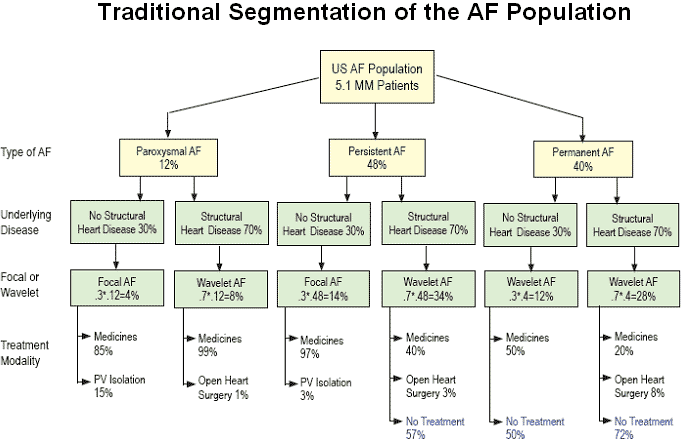Convergent Procedure: Outcomes Comparison
Critical factors in determining treatment and outcomes
Focal versus wavelet AF
For patients with focal AF, their arrhythmia is a result of a small grouping of cells, foci, sending erratic electrical signals. It is believed that often these foci are located in the pulmonary veins and thus the growth of pulmonary vein isolation (PVI) techniques. Physicians have assumed that focal AF is the primary cause of paroxysmal AF. However, there is no diagnostic to determine this, and wavelet AF can cause paroxysmal AF.
In wavelet patients, AF is caused by macro reentrant circuits that can be located across both atria. Therefore, the “cut & sew” maze procedure was developed to create a comprehensive lesion pattern across both atria in order to interrupt these electrical signals. Given that the maze pattern works on wavelet patients, it is expected to be even more effective for focal patients than a mini-maze technique.

The exact cause of atrial fibrillation is not well understood. Most researchers believe that AF is due primarily to errant electrical signals within the heart that cause the atria to beat asynchronously with the rest of the heart. Research suggests these erratic electrical signals can originate from a small grouping of cells on or near the pulmonary veins or more generally originate from various areas in the heart. AF that originates from a single source, or foci, of cells is called focal AF. AF that originates from various locations in the left and right atria is termed wavelet AF. Historically, the assumption has been that arrhythmias triggered by focal points within the pulmonary veins are primarily associated with paroxysmal AF. However, there is currently no method to determine if AF is focal or wavelet in nature and wavelet AF may also be paroxysmal in some patients.
Structural heart disease (Coronary Artery Disease, Mitral and Aortic Valve Disease) is associated with the development of AF. Often patients with some type of structural heart disease require heart surgery. During open heart surgery, patients who have AF related to structural heart disease can undergo an ablation procedure to treat their AF at the same time.
What type of AF do you have?

Between 83%-87% of all AF patients have wavelet AF. The breakdown between focal and wavelet paroxysmal patients is unknown, but whether AF is focal or wavelet and whether AF is Paroxysmal, Persistent, Long-Standing Persistent, or Permanent is important to determining the best treat options for the AF patient.

Comparison of Outcomes
When evaluating outcomes for AF treatment options, carefully evaluate the results based upon:
- The type of AF;
- The duration of AF;
- The size of the left atrium;
- How the results are reported (% in normal rhythm; % freedom from AF; % not taking antiarrhythmic medications [AADs])
- How long the patient is evaluated to determine success (10 second ECG; 24 hour Holter monitor; 7 day monitor)
* Gallagher MM, Camm AJ. Classification of atrial fibrillation. PACE. 1992;20:1603-1605
|



